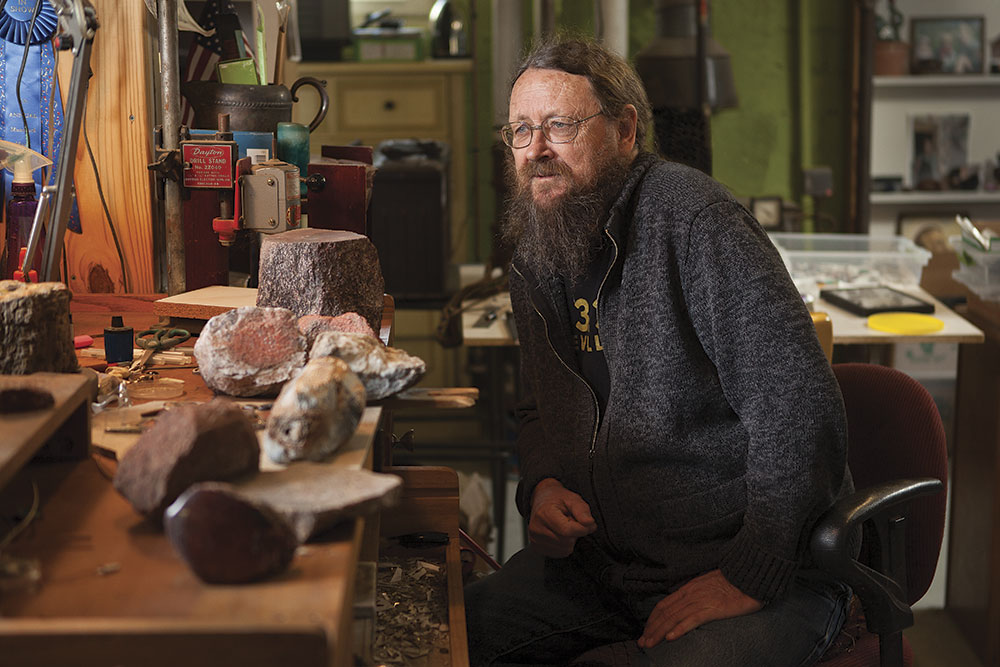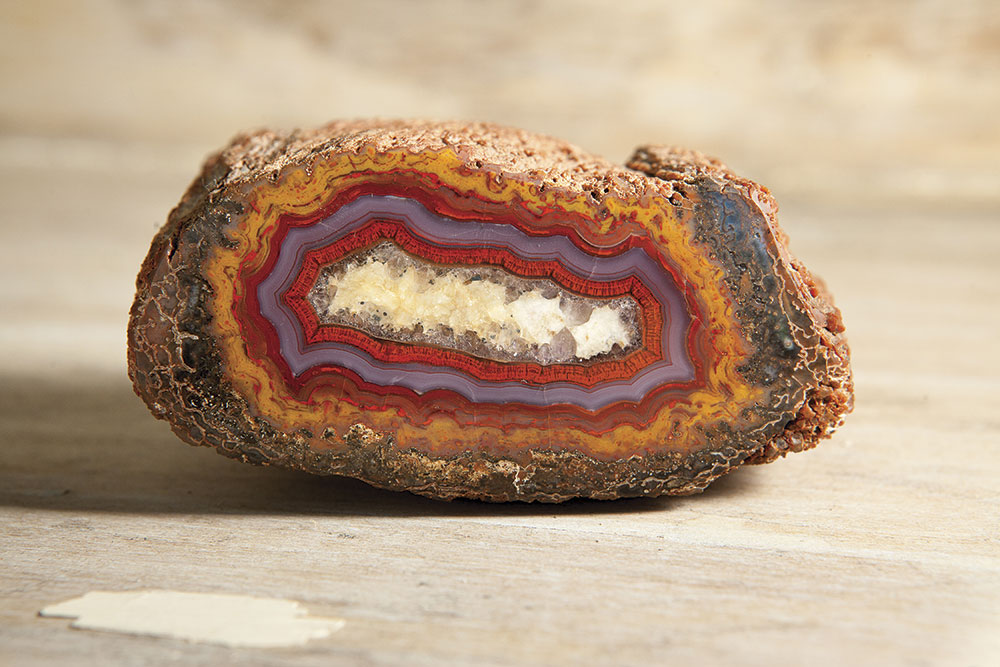
Scott Owen of Asheville traces his passion for collecting rocks and minerals to his childhood. “I grew up in Tucson, Arizona, where there was a 9,000-foot-tall mountain basically in my own backyard. There were silver, copper, and even gold mining operations in the area, too, so I was surrounded by rocks and the beauty of rocks, and I was fascinated by it all.”
At age 21, he moved to Moab, Utah, near the Colorado border. The area around Moab is known for rich uranium deposits, famous natural arches — and for being the place where the epic final scene of the movie Thelma and Louise was shot.
“In the 1970s, Moab was a dinky little town about the size and character of Mayberry,” Owen recalls. “I showed up and got a job at Moab Rock Shop.” Part of Owen’s job was to conduct guided tours at nearby Canyonlands National Park, teaching people about the geological history of the area. “The guy I replaced accidentally fell to his death at the same place where Thelma and Louise went over the cliff in their car,” he reveals. Owen also spent many hours sitting in the window of the shop making jewelry to sell to the tourists.

“The owner was a fellow named Lin Ottinger,” Owen recalls. “He was from Tennessee and had no formal education. He couldn’t even read. But there wasn’t anything he didn’t know something about, and in many ways he was a genius. He discovered a lot of the natural arches people now take tours to; he had a lot to do with getting Canyonlands designated as a National Park; he’s been written up in National Geographic a couple of times, and he even has a dinosaur named after him.”
Ottinger was also the first to discover that some of the dinosaur bones in that isolated area of the world had petrified into rocks that were the quality of gemstone. Local prospectors stumbled upon dinosaur-bone fragments all the time, but Ottinger recognized their value and rarity. He introduced Owen to the those pieces of breathtakingly gorgeous bone-turned-gemstone, and Owen began collecting them — smitten by their vibrantly colorful and alluringly unique aesthetic characteristics.
“Most dinosaur bones are kind of a gray or brownish color,” explains Owen. “But when the ones found in this one little place around Moab fossilized, they turned into agate — which has all the beauty and hardness of gemstone.”
He is often asked how that evolution was possible, and explains that what began as a dinosaur bone 160 million years ago underwent a slow and gradual process of natural erosion, deterioration, and organic transformation. As water leeched colored minerals into the bones, the dull beige or grayish material was stained. Tiny bits of mineral also got deposited into the microscopic voids and cellular geometry of the decomposing bones. Over time the bone was entirely replaced with minerals — so it was technically no longer a bone, but a rock.
Depending upon the specific mineral content present within a dinosaur bone, it would take on gorgeously colorful attributes that are visibly enhanced by polishing. Azurite, a mineral associated with copper, adds blue or green, while iron deposits show up as deep, rich red. Yellowish hues, on the other hand, are an indication that the mineral composition was influenced by uranium.
Once they are skillfully polished to a high luster, petrified dinosaur bones reveal breathtakingly dramatic color variations in exquisite patterns that vary from one bone fragment to the next.
“In Moab in those days,” Owen remembers, “people would find these chunks of petrified bone in places like dry creek beds and bring them home. Everyone kept little piles of them in their front yards and on their porches for decoration, the way people who live at the beach do with seashells and driftwood. I fell in love with petrified dinosaur-bone rocks, and began buying them for a good price from people who collected them. I was also making them into one-of-a-kind pieces of jewelry. It was a very natural thing and rather inevitable that I would wind up developing that into a collection.”
Owen is quick to emphasize, however, that nothing in his collection was acquired by scavenging dinosaur skeletons of value to scientists, archaeologists, or other researchers.
“When I was selling jewelry,” Owen says, “I had paleontologists come up to my booth. Right away they would recognize the gemstones as petrified dinosaur bone. They understood that these bones that I was using were not any good to them on any kind of a level of scientific importance. Of course they were concerned about people going out into the countryside and stealing skeletons. But that’s not what these are. These are just little broken-up fragments of bone washed out during the erosion process. Left alone, they would get a little smaller and smaller each year, until they turned into sand.
The artist is semi-retired from the craft-show circuit, and while he does make occasional appearances at local festivals, he mostly sells out of his home, or via his Facebook page.
“You could say that we are saving these bones, by turning them into gemstones and collectible jewelry that people want to hold on to, preserve, and pass down to future generations.”
Contact Scott Owen at 828-775-9202, via e-mail (owengoodlove@yahoo.com), or on Facebook.
